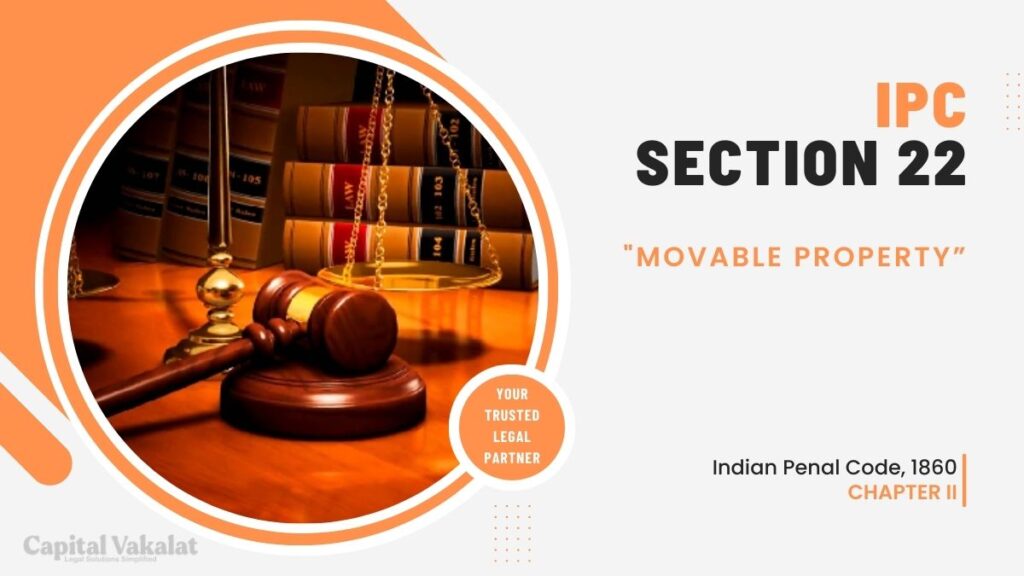When it comes to the Indian Penal Code (IPC), section 22 holds significant importance as it deals with the concept of “movable property.” In legal terms, movable property refers to assets or belongings that can be easily transported and are not fixed to any specific location.

This article will delve into the intricacies of section 22 IPC, shedding light on the definition of movable property, its classification, and the implications of its inclusion in the Indian legal framework.
Introduction to Section 22 IPC
Section 22 of the Indian Penal Code (IPC) plays a crucial role in defining and interpreting the legal term “movable property.” This section serves as the foundation for various criminal offenses that involve the misappropriation, theft, or damage of movable property.
Defining Movable Property
Movable property encompasses a broad range of assets that can be physically transported or transferred from one place to another. This can include items such as vehicles, electronics, jewelry, cash, and even livestock. In contrast to immovable property, which includes land and buildings, movable property’s distinguishing feature is its inherent ability to be shifted.
Classification of Movable Property
Movable property can be further classified into two categories: corporeal and incorporeal. Corporeal movable property includes tangible assets that have a physical form, such as vehicles, machinery, and personal belongings. Incorporeal movable property, on the other hand, refers to assets that lack a physical presence but hold value, like copyrights, patents, and trademarks.
Importance in Criminal Offenses
Section 22 IPC serves as a pivotal element in various criminal offenses, particularly those related to theft, robbery, and fraud. The inclusion of this section aids in determining the nature and value of the property involved in the offense, which subsequently influences the severity of the punishment.
Case Studies: Section 22 in Action
Numerous legal cases have relied on section 22 IPC to establish the status of property as movable. For instance, in the case of State v. Rajkumar, the court’s interpretation of section 22 played a crucial role in determining the guilt of the accused in a theft case.
Challenges in Determining Movable Property
Despite the clear distinction between movable and immovable property, certain scenarios pose challenges in classification. For example, disputes may arise when determining whether a fixture attached to a building should be considered movable property.
Role of Movable Property in Theft Cases
Movable property is central to defining theft under section 378 IPC. The unlawful taking or moving of movable property with the intent to deprive the rightful owner of their possession is considered theft and is punishable under the law.
The Intersection with Other Legal Sections
Section 22 IPC often intersects with other legal sections, such as those related to criminal breach of trust, extortion, and criminal misappropriation. The interpretation of movable property’s definition plays a crucial role in establishing the scope of these offenses.
Protecting Ownership Rights
The concept of movable property is closely tied to ownership rights. Ensuring the protection of these rights requires a clear understanding of what constitutes movable property, preventing unwarranted disputes and legal battles.
Evolving Interpretations of Movable Property
Over the years, courts have adapted their interpretation of movable property to keep up with changing times and advancements in technology. This adaptability ensures that the legal framework remains relevant and effective.
Legislative Amendments and Updates
Legislative amendments have occasionally been made to section 22 IPC to address emerging challenges in defining movable property. These updates reflect the evolving nature of personal belongings and assets.
Precedents Set by Court Rulings
Landmark court rulings have set precedents for determining the status of movable property. These judgments influence how future cases are approached and decided, bringing consistency to legal proceedings.
Safeguarding Movable Property Rights
Property owners are encouraged to take precautionary measures to safeguard their movable assets. Employing security systems, insurance, and legal agreements can help deter theft and unauthorized transfer.
Future Implications and Trends
As technology continues to reshape the landscape of personal belongings, the definition and protection of movable property may face new challenges. Courts and lawmakers will need to adapt to these changes while upholding the principles of justice.
Conclusion
In conclusion, section 22 IPC serves as the cornerstone for understanding and addressing movable property in the Indian legal context. Its comprehensive definition and classification lay the groundwork for various criminal cases, ensuring that justice is served while preserving ownership rights.
Here are some external resources where you can find more details about Section 22 IPC and the concept of “movable property”:
- Indian Penal Code (IPC): Official text of the Indian Penal Code including Section 22, providing legal definitions and context.
- Lawrato – Section 22 IPC: An in-depth article explaining the implications and interpretations of Section 22 IPC in relation to movable property.
- Youtube – “Understanding Movable and Immovable Property”: An informative video discussing the distinction between movable and immovable property, relevant to Section 22 IPC.
- Ecourts – “Indian Penal Code”: A guide to IPC laws in India, including information and its legal implications.
Please note that while these resources provide valuable insights, it’s important to cross-reference information and consult legal professionals for accurate and up-to-date guidance.
FAQs
How is movable property classified?
Movable property can be classified as corporeal (tangible assets) and incorporeal (intangible assets like copyrights).
Can movable property be part of immovable property?
In some cases, movable property might be attached to immovable property, leading to classification challenges.
How does section 22 IPC relate to theft cases?
Section 22 IPC helps determine whether property is movable in cases of theft and influences the severity of punishment.
How does technology impact the definition of movable property?
Advancements in technology may lead to new forms of movable property, necessitating adaptations in legal interpretations and definitions.